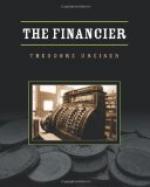The services which Cowperwood performed during the ensuing year and a half for Stener, Strobik, Butler, State Treasurer Van Nostrand, State Senator Relihan, representative of “the interests,” so-called, at Harrisburg, and various banks which were friendly to these gentlemen, were numerous and confidential. For Stener, Strobik, Wycroft, Harmon and himself he executed the North Pennsylvania deal, by which he became a holder of a fifth of the controlling stock. Together he and Stener joined to purchase the Seventeenth and Nineteenth Street line and in the concurrent gambling in stocks.
By the summer of 1871, when Cowperwood was nearly thirty-four years of age, he had a banking business estimated at nearly two million dollars, personal holdings aggregating nearly half a million, and prospects which other things being equal looked to wealth which might rival that of any American. The city, through its treasurer—still Mr. Stener—was a depositor with him to the extent of nearly five hundred thousand dollars. The State, through its State treasurer, Van Nostrand, carried two hundred thousand dollars on his books. Bode was speculating in street-railway stocks to the extent of fifty thousand dollars. Relihan to the same amount. A small army of politicians and political hangers-on were on his books for various sums. And for Edward Malia Butler he occasionally carried as high as one hundred thousand dollars in margins. His own loans at the banks, varying from day to day on variously hypothecated securities, were as high as seven and eight hundred thousand dollars. Like a spider in a spangled net, every thread of which he knew, had laid, had tested, he had surrounded and entangled himself in a splendid, glittering network of connections, and he was watching all the details.
His one pet idea, the thing he put more faith in than anything else, was his street-railway manipulations, and particularly his actual control of the Seventeenth and Nineteenth Street line. Through an advance to him, on deposit, made in his bank by Stener at a time when the stock of the Seventeenth and Nineteenth Street line was at a low ebb, he had managed to pick up fifty-one per cent. of the stock for himself and Stener, by virtue of which he was able to do as he pleased with the road. To accomplish this, however, he had resorted to some very “peculiar” methods, as they afterward came to be termed in financial circles, to get this stock at his own valuation. Through agents he caused suits for damages to be brought against the company for non-payment of interest due. A little stock in the hands of a hireling, a request made to a court of record to examine the books of the company in order to determine whether a receivership were not advisable, a simultaneous attack in the stock market, selling at three, five, seven, and ten points off, brought the frightened stockholders into the market with their holdings. The banks considered the line a poor risk, and called their loans in connection




